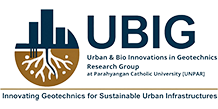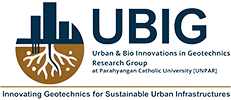Table of Contents
- Undergraduate Courses:
- Graduate Courses:
Undergraduate Courses
Soil Mechanics
Soil Mechanics is a foundational subject in civil engineering that explores the behavior and properties of soils under various loading and environmental conditions. The course begins with an introduction to the origin and types of soils, emphasizing their formation and classification systems such as the Unified Soil Classification System (USCS) and AASHTO. Students learn about the physical properties of soils, including particle size distribution, Atterberg limits, specific gravity, water content, and unit weight relationships. The course delves into permeability and seepage, covering Darcy’s law, flow nets, and capillary action. Compaction behavior is studied through standard and modified Proctor tests, highlighting field applications and equipment. A core principle, effective stress, is introduced to explain the interactions between soil particles and pore water pressure. Consolidation theory is examined through Terzaghi’s model, with emphasis on laboratory testing and settlement analysis. The shear strength of soils is explored through Mohr-Coulomb theory and tests such as direct shear, triaxial, and unconfined compression.
Soil Investigation
Soil Investigation is a specialized course in geotechnical engineering that focuses on methods and techniques for characterizing subsurface soil conditions to support civil engineering design and construction. The course begins with an overview of site investigation objectives, planning, and the stages of exploration, including desk studies and preliminary assessments. Students learn about direct and indirect investigation methods such as test pits, borehole drilling, and various in-situ testing techniques including Standard Penetration Test (SPT), Cone Penetration Test (CPT). Emphasis is placed on soil sampling methods, sample classification (disturbed vs. undisturbed), and laboratory testing to determine index and engineering properties of soils such as grain size distribution, Atterberg limits, shear strength, and compressibility. Practical components may include field exercises and lab work to develop the skills necessary for conducting reliable and effective subsurface investigations for engineering projects.
Design of Earth Retaining Structures
Design of Earth Retaining Structures is a geotechnical engineering course focused on the analysis and design of structures that retain soil and resist lateral earth pressures. The course begins with a review of fundamental earth pressure theories, including Rankine and Coulomb methods, and their application in determining active, passive, and at-rest pressures under various ground conditions. Students study the behavior and design of gravity walls and cantilever retaining walls. Sheet pile walls and anchored bulkheads are analyzed using limit equilibrium and moment equilibrium methods, incorporating the use of free earth support and fixed earth support methods.
Foundation Engineering
Foundation Engineering is a core subject in geotechnical and structural engineering that deals with the analysis, design, and construction of foundation systems that safely transfer structural loads to the ground. The course begins with the classification of foundations into shallow and deep types, and criteria for their selection based on soil conditions, structural requirements, and site constraints. Students learn about the evaluation of soil bearing capacity using Terzaghi’s and Meyerhof’s theories, and settlement analysis including immediate, primary consolidation, and secondary settlements. The design of shallow foundations such as isolated footings, combined footings, strip footings, and mat foundations is covered in detail, incorporating both ultimate and serviceability limit states. The course then advances to deep foundations, covering pile classification, load-carrying capacity estimation using static and dynamic methods, group effects, and pile settlement. Construction techniques, installation effects, and quality control measures such as pile driving analysis and integrity testing are discussed. Lateral load analysis of piles and drilled shafts is also introduced using simplified methods.
Advanced Geotechnical Analysis
Advanced Geotechnical Analysis is a electivel course designed to equip students with the theoretical knowledge and computational tools needed to analyze complex geotechnical problems. The course begins with a review of stress-strain behavior of soils, constitutive models for soil (e.g., Mohr-Coulomb), and nonlinear soil behavior under static and dynamic loading. The course covers slope stability analysis using limit equilibrium methods (e.g., Bishop, Janbu, Morgenstern-Price) and introduces finite element modeling (FEM) techniques for both slope stability and stress-deformation analysis. Settlement and consolidation analysis is extended to multi-dimensional and staged loading problems, with emphasis on soft soil models and preloading techniques. The behavior of retaining structures and shallow and deep foundations under complex loading conditions—including seismic and cyclic loading—is evaluated using numerical methods. Students gain hands-on experience with geotechnical software such as PLAXIS, GeoStudio, or MIDAS GTS NX for modeling geotechnical systems. The course also includes critical discussions of boundary conditions, mesh refinement, and validation of numerical models using field and laboratory data. Real-world case histories are used throughout to illustrate modeling challenges and interpretation of results, preparing students for research or advanced engineering practice in geotechnical analysis.
Graduate Courses
Deep Excavation and Tunnel Engineering
Types of tunnels and their purposes, geological and geotechnical aspects in tunnel design, tunnel modeling using finite elements, types and methods of tunnel structure reinforcement, stages of tunnel construction, types and methods of tunnel instrumentation, tunnel failure risks and types, case studies of tunnel construction. Types of earth-retaining structures and excavation methods, dewatering concepts, excavation design in expansive soils, case studies of deep excavations, geotechnical aspects and excavation design in soft soils, additional reinforcement on retaining walls, excavation analysis using conventional methods (beam on elastic foundation approach) and finite element methods, excavation design with soil nailing reinforcement.
Soft Soil Engineering and Soil Improvement
Expansive soils, consolidation concepts, CPTu in consolidating soft soils, deep excavations in soft soil (case histories), geotechnical failure in soft soils and its mitigation, soft soil characteristics, ground improvement of soft soils using preloading and PVD, including instrumentation, pile driving effects on soft soil. Principles of ground improvement, expansive soil, organic and peat soil, deep compaction, dynamic compaction, preloading and vertical drains, stone columns, grouting, underpinning, diaphragm wall, application of geotextiles and geomembranes, soil anchoring, soil nailing.
Soil Dynamics and Geotechnical Earthquake Engineering
Principles of vibration theory, wave propagation in soil, dynamic soil parameters, dynamic response of soils, vibration on foundations, effects of vibration on structures, machine foundation design, earthquakes and ground vibrations, response spectrum, SHAKE computer program application, liquefaction in sandy soils, liquefaction potential evaluation methods, simple shear and cyclic triaxial tests, field test applications for liquefaction analysis.
Advanced Soil Mechanics
Principles of soil mechanics, effective stress principle, stress distribution in soil, settlement, one-dimensional and three-dimensional consolidation, shear strength of soil and laboratory testing methods, in-situ testing and interpretation methods, flow theory and permeability, as well as unsaturated soil mechanics.

